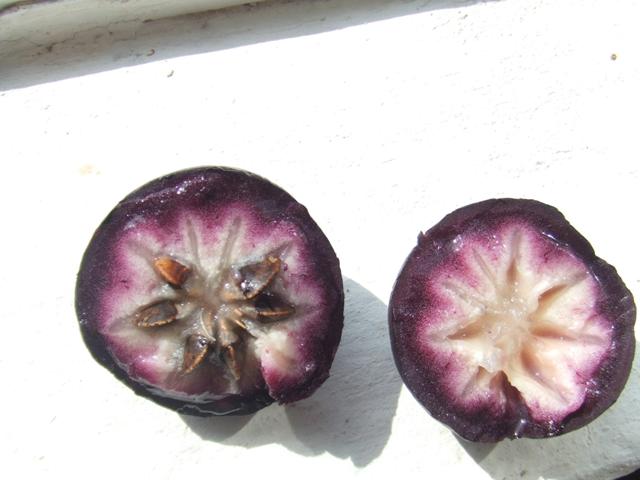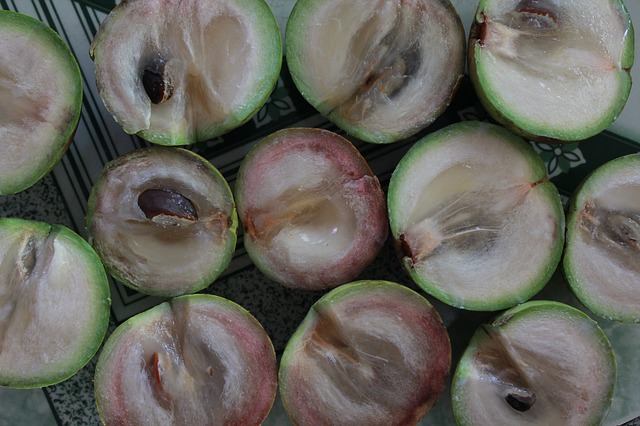Star Apple: Origins - Consumption - Nutrition Facts - Health Benefits
|
|
|
Contents
- Geographic origin and regions grown
- Common consumption today
- Nutrition Facts: Vitamins, minerals and phytochemical components
- Health Benefits: Medicinal uses based on scientific studies
- Bibliography
Geographic Origins and Regions Grown

The tropical American tree known as star apple, of the sapodilla family, originates in Central America and the Caribbean. Named for its star-shaped core, the star apple comes in two varieties. There is the delicious dark purple skinned variety with red-purple pulp, or the equally delicious green skinned variety with clear-white pulp. In Vietnam the green version is known as Vu Sua or “milk from the breast”.
Cultivated for its delicious juice as well as its edible fruit, the star apple is the size and shape of an apple. The surface is firm and smooth encasing a soft, sweet pulp. It is a star in numerous tropical parts of the world.
Common Consumption Today
When eaten fresh it is best to avoid the bitter-tasting rind. In Vietnam they squeeze the green fruit, which is juicier than the purple variety, until it is tender and the juice mixes with the pulp. Then they drill a tiny hole in the top and drink the juice like a baby on a mother’s breast.
To prepare to eat the flesh, cut through the rind completely to about the middle of the fruit. Hold the fruit stem side down and gently twist the top off. This technique eases the removal of most of the core when you pull away the top so the pulp can be spooned out.
It is sweet and it is a disservice to not have this fruit chilled. You must add this fruit to salads and other delicacies. Or create a beautiful fruit salad ice as they do in Jamaica with chopped mango, pineapple citrus, coconut and whatever other fruits you prefer. Jamaica prepares a combo called “matrimony” which mixes the sweetness of the star apple with sour orange juice. They like to prepare their “strawberries and cream” dessert that also combines orange juice with a little sugar, grated nutmeg and a spoonful of sherry with the star apple.
In Bolivia the star apple flesh is parboiled and can be prepared as a decoction. Emulsifying the bitter seed kernels for use in making confections like imitation milk-of-almonds and nougats is quite popular as well.
Nutrition Facts: Vitamins, Minerals and Phytochemical Components

The star apple is just a bit under the radar in relation to its health benefits. Currently it looks as if the only institution conducting research on sapodilla, including the star apple, in the world is CUNY. The first scientist to identify antioxidants is Dr. Edward Kennelly and research is still ongoing.
Health Benefits: Medicinal Uses Based on Scientific Studies
Star apple is another example of a plant that can have many uses from rind to seed.
The bitter, pulverized seed is taken as a tonic, diuretic and febrifuge. Infusions of the leaves have been used against diabetes and articular rheumatism. A decoction of the rind, or of the leaves, is taken as a pectoral to relieve lung or respiratory troubles.
The bark which is tannin-rich and astringent is used to create a decoction that can be used to treat diarrhea, dysentery and hemorrhages. The same decoction is used for treating gonorrhea and painful bladder infections. A decoction of leaves is thought to be a useful cancer remedy.
One of the healthy benefits of the ripe fruit includes its mucilaginous character. When eaten it can sooth inflammation in laryngitis and pneumonia conditions. Ripe fruit is also given to treat diabetes mellitus. A decoction of the fresh ripe fruit is gargled to relieve angina (1).
Unripe fruit is beneficial as well. It can be eaten to comfort intestinal disturbances. However, too much ripe fruit could cause constipation.
Its latex is used for abscesses and the dried latex is used as a treatment for parasites.
Bibliography
1. Einbond, L. S., Reynertson, K. A., Luo, X.-D., Basile, M. J., & Kennelly, E. J. (2004). Anthocyanin antioxidants from edible fruits. Food Chemistry, 84(1), 23.
Disclaimer
Nutritiousfruit.com provides this website as a service. Although the information contained within the website is periodically updated, no guarantee is given that the information provided is correct, complete, and/or up-to-date. The materials contained on this website are provided for general information purposes only and do not constitute legal or other professional advice on any subject matter. Nutrtiousfruit.com does not accept any responsibility for any loss, which may arise from reliance on information contained on this website. The information and references in this website are intended solely for the general information for the reader. The content of this website are not intended to offer personal medical advice, diagnose health problems or to be used for treatment purposes. It is not a substitute for medical care provided by a licensed and qualified health professional. Please consult your health care provider for any advice on medications.
Didn't find what you were looking for? Search here...

Amazon Search Box:
Did you like this page?
|
|
|




